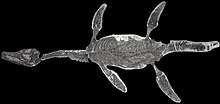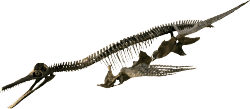Leurospondylus
Leurospondylus is a genus of plesiosaur whose family is currently disputed, but is suggested to be Plesiosauridae.
| Leurospondylus Temporal range: Late Cretaceous | |
|---|---|
| Dorsal view of the spine of Leurospondylus | |
| Scientific classification | |
| Kingdom: | |
| Phylum: | |
| Class: | |
| Superorder: | |
| Order: | |
| Suborder: | |
| Family: | |
| Genus: | Leurospondylus |
| Species | |
| |
Etymology
The name Leurospondylus comes from a fusion of two Greek words, leuros (λευρός) meaning "even", "flat" or "smooth", and spondylos (σπόνδυλος) meaning "vertebra."[1] The name of the type species L. ultimus comes from the Latin ultimus meaning "last." It was so named because this genus was the latest known occurrence of a fossil plesiosaur when it was described in 1913."[1]
Description
The first described Leurospondylus was a juvenile.[2] The fossil included 12 vertebrae but the animal is thought to have had twice that number,[2] and was estimated to be roughly 2 meters long as a juvenile.[2] Samuel Paul Welles noted that the vertebrae are short and similar to those of pliosaurs,[3] while the scapulae and coracoids bear resemblance to those of elasmosaurids,[3] thus making it difficult to determine to which family it belongs.[3] There is some speculation that the Leurospondylus specimen is either a juvenile of a known species, or in its own, unrecognized taxonomic group.[1]
Distribution
The first Leurospondylus was found in the brackish paleoenvironment represented by the Edmonton beds located on the present-day Red Deer River. This area is part of the Horseshoe Canyon Formation in Alberta, Canada.[1] The occurrence of this juvenile fossil in an identifiably brackish environment led to the conclusion that plesiosaurs spent their early lives in rivers and estuaries.[1] However, some plesiosaurs spent their adult lives in fresh water also; whether Leurospondylus grew up and then left, or grew up and stayed in a fresh water ecosystem has not been determined.[1]
References
- "ppne.co.uk entry on Leurospondylus". Retrieved 2008-05-20.
- "A new plesiosaur, Leurospondylus, from the Edmonton Cretaceous of Alberta". Bulletin of the AMNH; v. 32, article 40.
- Welles, S. P. 1962. A new species of elasmosaur from the Aptian of Columbia and a review of the Cretaceous plesiosaurs. University of California Publications in Geological Science 46, 96 pp.




